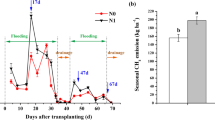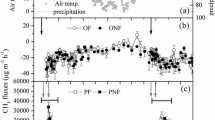Abstract
Purpose
Methane-oxidizing bacteria (methanotrophs) biologically consume and consequently affect the concentration of atmospheric methane (CH4), the second most prominent greenhouse gas, and therefore play critical roles in the mitigation of global warming effect. Long-term fertilization often affects the methanotrophic community and CH4 oxidation in various soils. Here, the immediate effects of nitrogen (N), phosphorus (P), and potassium (K) amendments on the CH4 oxidation activity and methanotrophic community structure were evaluated.
Materials and methods
Paddy soil samples were collected from the Taoyuan Experimental Station of the Chinese Academy of Sciences in central Hunan Province of China. A laboratory-based incubation experiment was conducted to investigate the immediate effects of N, P, and K amendments on the methanotrophs in soil. The CH4 oxidation rates and methanotrophic activities were determined by measuring the dynamic changes of CH4 concentration in the incubation system. The methanotrophic abundance and community changes in all of the seven treatments with and without nutrients addition were studied using real-time PCR and denaturing gradient gel electrophoresis, respectively.
Results and discussion
All of the N, P, and K treatments significantly decreased the CH4 oxidation activities. Compared with the control, the P and K amendments significantly increased the methanotrophic population size, but the N treatments have no effect on the methanotrophic abundance. A negative correlation was found between methanotrophic activity and methanotrophic abundance. We suggested that methanotrophic activity may not be inferred through the pmoA gene copies, especially in the short-term simulation experiments. Investigation of the methanotrophic population size and diversity is not enough to evaluate the soil CH4 sink accurately.
Conclusions
We concluded that the additions of N, P, and K reduce the activity but enhance the abundance of methanotrophs in a Chinese paddy soil through a short-term incubation experiment. Additionally, we found that the CH4 oxidation activity could be completely inhibited by Cl− toxicity. Our results implied that caution should be exercised in the types and amounts of fertilizers, especially KCl in agricultural systems to control the instantaneous increase in CH4 emission from the field.




Similar content being viewed by others
References
Aronson EL, Helliker BR (2010) Methane flux in non-wetland soils in response to nitrogen addition: a meta-analysis. Ecology 91:3242–3251
Babu YJ, Nayak DR, Adhya TK (2006) Potassium application reduces methane emission from a flooded field planted to rice. Biol Fertil Soils 42:532–541
Bodelier PLE (2011) Interactions between nitrogenous fertilizers and methane cycling in wetland and upland soils. Curr Opin Environ Sustain 3:379–388
Bodelier PLE, Laanbroek HJ (2004) Nitrogen as a regulatory factor of methane oxidation in soils and sediments. FEMS Microbiol Ecol 47:265–277
Bodelier PLE, Roslev P, Henckel T, Frenzel P (2000) Stimulation by ammonium-based fertilizers of methane oxidation in soil around rice roots. Nature 403:421–424
Börjesson G, Sundh I, Tunlid A, Frostegard A, Svensson BH (1998) Microbial oxidation of CH4 at high partial pressures in an organic landfill cover soil under different moisture regimes. FEMS Microbiol Ecol 26:207–217
Conrad R, Donald LS (2007) Microbial ecology of methanogens and methanotrophs. Advances in agronomy. Academic, New York, pp 1–63
Conrad R, Klose M (2005) Effect of potassium phosphate fertilization on production and emission of methane and its 13C-stable isotope composition. Soil Biol Biochem 37:2099–2108
Costello AM, Lidstrom ME (1999) Molecular characterization of functional and phylogenetic genes from natural populations of methanotrophs in lake sediments. Appl Environ Microbiol 65:5066–5074
Dan JG, Krüger M, Frenzel P, Conrad R (2001) Effect of a late season urea fertilization on methane emission from a rice field in Italy. Agric Ecosyst Environ 83:191–199
Di HJ, Cameron KC, Shen JP, Winefield CS, O’Callaghan M, Bowatte S, He JZ (2011) Methanotroph abundance not affected by applications of animal urine and a nitrification inhibitor, dicyandiamide, in six grazed grassland soils. J Soils Sediments 11:432–439
Dubey SK, Singh JS (2000) Spatio-temporal variation and effect of urea fertilization on methanotrophs in a tropical dryland rice field. Soil Biol Biochem 32:521–526
Dumont MG, Radajewski SM, Miguez CB, McDonald IR, Murrell JC (2006) Identification of a complete methane monooxygenase operon from soil by combining stable isotope probing and metagenomic analysis. Environ Microbiol 8:1240–1250
Dunfield PF, Topp E, Archambault C, Knowles R (1995) Effect of nitrogen fertilizers and moisture content on CH4 and N2O fluxes in a humisol: measurements in the field and intact soil cores. Biogeochemistry 29:199–222
Gulledge J, Hrywna Y, Cavanaugh C, Steudler PA (2004) Effects of long-term nitrogen fertilization on the uptake kinetics of atmospheric methane in temperate forest soils. FEMS Microbiol Ecol 49:389–400
Han JI, Lontoh S, Semrau JD (1999) Degradation of chlorinated and brominated hydrocarbons by Methylomicrobium album BG8. Arch Microbiol 172:393–400
Hanson RS, Hanson TE (1996) Methanotrophic bacteria. Microbiol Rev 60:439–471
He JZ, Zheng Y, Chen CR, He YQ, Zhang LM (2008) Microbial composition and diversity of an upland red soil under long-term fertilization treatments as revealed by culture-dependent and culture-independent approaches. J Soils Sediments 8:349–358
Holmes AJ, Roslev P, McDonald IR, Iversen N, Henriksen K, Murrell JC (1999) Characterization of methanotrophic bacterial populations in soils showing atmospheric methane uptake. Appl Environ Microbiol 65:3312–3318
Horz HP, Rich V, Avrahami S, Bohannan BJM (2005) Methane-oxidizing bacteria in a California upland grassland soil: diversity and response to simulated global change. Appl Environ Microbiol 71:2642–2652
Hütsch BW (2001) Methane oxidation in non-flooded soils as affected by crop production–invited paper. Eur J Agron 14:237–260
Hütsch BW, Webster CP, Powlson DS (1994) Methane oxidation in soil as affected by land use, soil pH and N fertilization. Soil Biol Biochem 26:1613–1622
IPCC (2007) Summary for policymakers. Climate change 2007: the physical science basis. In: Solomon S, Qin D, Manning M, Chen Z, Marquis M, Averyt KB, Tignor M, Miller HL (eds) Contribution of Working Group I to the Fourth Assessment Report of the Intergovernmental Panel on Climate Change. Cambridge University Press, Cambridge, pp 539–543
Jang I, Lee S, Zoh K-D, Kang H (2011) Methane concentrations and methanotrophic community structure influence the response of soil methane oxidation to nitrogen content in a temperate forest. Soil Biol Biochem 43:620–627
King GM (1997) Responses of atmospheric methane consumption by soils to global climate change. Glob Change Biol 3:351–362
Knief C, Lipski A, Dunfield PF (2003) Diversity and activity of methanotrophic bacteria in different upland soils. Appl Environ Microbiol 69:6703–6714
Kolb S (2009) The quest for atmospheric methane oxidizers in forest soils. Environ Microbiol Rep 1:336–346
Le Mer J, Roger P (2001) Production, oxidation, emission and consumption of methane by soils: a review. Eur J Soil Biol 37:25–50
Lee SY, Lee SH, Jang JK, Cho KS (2011) Comparison of methanotrophic community and methane oxidation between rhizospheric and non-rhizospheric soils. Geomicrobiol J 28:676–685
Liu L, Gundersenb P, Zhang T, Mo JM (2012) Effects of phosphorus addition on soil microbial biomass and community composition in three forest types in tropical China. Soil Biol Biochem 44:31–38
Lu Y, Wassmann R, Neue HU, Huang C (1999) Impact of phosphorus supply on root exudation, aerenchyma formation and methane emission of rice plants. Biogeochemistry 47:203–218
Lü F, He PJ, Guo M, Yang N, Shao LM (2012) Ammonium-dependent regulation of aerobic methane-consuming bacteria in landfill cover soil by leachate irrigation. J Environ Sci 24:711–719
Ma K, Lu YH (2011) Regulation of microbial methane production and oxidation by intermittent drainage in rice field soil. FEMS Microbiol Ecol 75:446–456
Menyailo OV, Hungate BA, Abraham WR, Conrad R (2008) Changing land use reduces soil CH4 uptake by altering biomass and activity but not composition of high-affinity methanotrophs. Glob Change Biol 14:2405–2419
Mohanty SR, Bodelier PLE, Conrad R (2007) Effect of temperature on composition of the methanotrophic community in rice field and forest soil. FEMS Microbiol Ecol 62:24–31
Nyerges G, Stein LY (2009) Ammonia cometabolism and product inhibition vary considerably among species of methanotrophic bacteria. FEMS Microbiol Lett 297:131–136
Rath AK, Ramakrishnan B, Rao VR, Sethunathan N (2005) Effects of rice-straw and phosphorus application on production and emission of methane from tropical rice soil. J Plant Nutr Soil Sci 168:248–254
Reay DS, Nedwell DB (2004) Methane oxidation in temperate soils: effects of inorganic N. Soil Biol Biochem 36:2059–2065
Richardson AE, Lynch JP, Ryan PR, Delhaize E, Smith FA, Smith SE, Harvey PR, Ryan MH, Veneklaas EJ, Lambers H, Oberson A, Culvenor RA, Simpson RJ (2011) Plant and microbial strategies to improve the phosphorus efficiency of agriculture. Plant Soil 349:121–156
Schimel J (2000) Global change: rice, microbes and methane. Nature 403:375–377
Schnell S, King GM (1995) Mechanistic analysis of ammonium inhibition of atmospheric methane consumption in forest soil. Appl Environ Microbiol 60:3514–3521
Seghers D, Top EM, Reheul D, Bulcke R, Boeckx P, Verstraete W, Siciliano SD (2003) Long-term effects of mineral versus organic fertilizers on activity and structure of the methanotrophic community in agricultural soils. Environ Microbiol 5:867–877
Seghers D, Siciliano SD, Top EM, Verstraete W (2005) Combined effect of fertilizer and herbicide applications on the abundance, community structure and performance of the soil methanotrophic community. Soil Biol Biochem 37:187–193
Semrau JD (2011) Current knowledge of microbial community structures in landfills and its cover soils. Appl Microbiol Biotechnol 89:961–969
Shrestha M, Shrestha PM, Frenzel P, Conrad R (2010) Effect of nitrogen fertilization on methane oxidation, abundance, community structure, and gene expression of methanotrophs in the rice rhizosphere. ISME J 4:1545–1556
Singh BK, Bardgett RD, Smith P, Reay DS (2010) Microorganisms and climate change: terrestrial feedbacks and mitigation options. Nat Rev Microbiol 8:779–790
Snyder CS, Bruulsema TW, Jensen TL, Fixen PE (2009) Review of greenhouse gas emissions from crop production systems and fertilizer management effects. Agric Ecosyst Environ 133:247–266
Steudler PA, Bowden RD, Melillo JM, Aber JD (1989) Influence of nitrogen fertilization on methane uptake in temperate forest soils. Nature 341:314–316
Tlustos P, Willison TW, Baker JC, Murphy DV, Pavlikova D, Goulding KWT, Powlson DS (1998) Short-term effects of nitrogen on methane oxidation in soils. Biol Fertil Soils 28:64–70
Wieczorek AS, Drake HL, Kolb S (2011) Organic acids and ethanol inhibit the oxidation of methane by mire methanotrophs. FEMS Microbiol Ecol 77:28–39
Yang N, Lü F, He PJ, Shao LM (2011) Response of methanotrophs and methane oxidation on ammonium application in landfill soils. Appl Microbiol Biotechnol 92:1073–1082
Zhang F, She YH, Zheng Y, Zhou ZF, Kong SQ, Hou DJ (2010) Molecular biologic techniques applied to the microbial prospecting of oil and gas in the Ban 876 gas and oil field in China. Appl Microbiol Biotechnol 86:1183–1194
Zheng Y, Zhang LM, Zheng YM, Di HJ, He JZ (2008) Abundance and community composition of methanotrophs in a Chinese paddy soil under long-term fertilization practices. J Soils Sediments 8:406–414
Zheng Y, Liu XZ, Zhang LM, Zhou ZF, He JZ (2010) Do land utilization patterns affect methanotrophic communities in a Chinese upland red soil? J Environ Sci 22:1936–1943
Zheng Y, Yang W, Sun X, Wang SP, Rui YC, Luo CY, Guo LD (2012) Methanotrophic community structure and activity under warming and grazing of alpine meadow on the Tibetan Plateau. Appl Microbiol Biotechnol 93:2193–2203
Zhou XQ, Wang YF, Huang XZ, Hao YB, Tian JQ, Wang JZ (2008a) Effects of grazing by sheep on the structure of methane-oxidizing bacterial community of steppe soil. Soil Biol Biochem 40:258–261
Zhou XQ, Wang YF, Huang XZ, Tian JQ, Hao YB (2008b) Effect of grazing intensities on the activity and community structure of methane-oxidizing bacteria of grassland soil in Inner Mongolia. Nutr Cycl Agroecosyst 80:145–152
Acknowledgments
We thank two anonymous reviewers for their valuable comments on previous versions of the manuscript. This study was supported by grants from the Ministry of Sciences and Technology of China (no. 2012CB956300), the Natural Science Foundation of China (no. 41001149), and the Chinese Academy of Sciences (no. KZCX2-YW-JC401).
Author information
Authors and Affiliations
Corresponding author
Additional information
Responsible editor: Yanfen Wang
Electronic supplementary material
Below is the link to the electronic supplementary material.
ESM 1
(DOC 4.88 MB)
Rights and permissions
About this article
Cite this article
Zheng, Y., Zhang, LM. & He, JZ. Immediate effects of nitrogen, phosphorus, and potassium amendments on the methanotrophic activity and abundance in a Chinese paddy soil under short-term incubation experiment. J Soils Sediments 13, 189–196 (2013). https://doi.org/10.1007/s11368-012-0601-2
Received:
Accepted:
Published:
Issue Date:
DOI: https://doi.org/10.1007/s11368-012-0601-2




